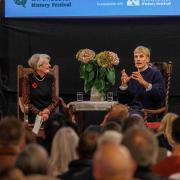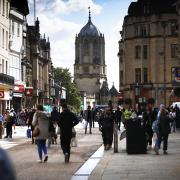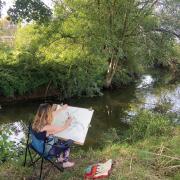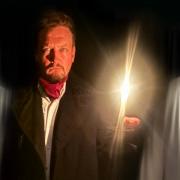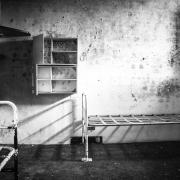A glimpse at Highworth and Sevenhampton and their characters as the Hammerman poet Alfred Williams knew them a century ago.
Alfred Williams would’ve been familiar with Highworth all his life. He was born in South Marston, just four miles up the road, in 1877. In 1892, aged just 15, he started walking four miles in the opposite direction to work at the GWR Railway Works in the ever-expanding town of Swindon. Although he worked in town, Williams was more at home in the countryside. He set out to record the songs, stories and lives of the local area around him in a series of books – including the past and present characters of Highworth.
Highworth’s High Street is described by Williams as a ‘charming confusion … of houses and shops’ most unlike the ‘formal and monotonous regularity’ he saw in Swindon every day. We start our walk here, heading left across the road onto Cricklade Road. Almost immediately you glimpse a grand Neo-classical house, Westrop House, which was built by Sir William Crowdy in 1818. Crowdy looms large in Highworth’s 19th-century history. A solicitor by trade, he became a major landowner, going on to buy the Manor of Highworth and become the squire.
According to Williams he was a bit of a character. It’s said that after a wrongdoing he’d walk around town with a rope halter trailing down from his neck so that all could know he’d done wrong. He even hired the town crier to subtly denounce a neighbour who hadn’t returned a half-peck measure he’d borrowed, the crier calling out, ‘If he doesn’t give it back, Mr Crowdy will never lend it to him anymore!’ It seems from letters that his wife was of a gentle and delicate disposition, so heaven knows what she thought of all this!

Crowdy died in 1838, but after his death his joking only intensified. His ghost still walked the streets of the town with the halter around his neck, but, much worse, in a feat of zombie-like strength, he would drag his coach up and down by its shafts, rattling and clanking and putting fear into the townsfolk. People hid indoors, not daring to go out, till at last a deputation of town worthies was despatched to Westrop House to lay the ghost. Crowdy didn’t want to go, and refused the Vicar’s call. Finally, he agreed to go if he could be laid in a barrel of cider! Down to the cellar he led them, and dived in as the vicar prayed. The cellar was quickly bricked up, and that, you would think, was that – but no. Westrop House is still said to be haunted by the figure of a man who politely knocks on the door and then fades away when it’s opened. Is this Crowdy back to playing little practical jokes now that the cider is all drunk away?
If you peer down the track on the right of the house, heading down to further houses built in what was once the stables, you might see another ghost, that of a White Lady. Some say she was Crowdy’s mistress, visiting him through the tunnels that are said to lie under the grounds, built for the servants to bring ice from the ice house in the garden. She’s seen in the house as well, and next door at the older Westrop Cottage, but I wouldn’t like to guess who she is – mistress of the house, or mistress of the man?
As we walk down Cricklade Road, we come, fittingly, to the cemetery, and more ‘ghosts’, although this time they are of a rather more corporeal nature… Head through the cemetery to a crossroads, then out through the gate and across the field, where you can see a good view of Hannington Hall, built in the 17th century. Once there lay a long avenue of elm trees, and along here, once a week, would come the shoemaker John Drew to preach in the next-door village of Hannington. Although he was a religious man, he was also a hard taskmaster, working his apprentices late into the night. One night, as he was making his way back through the elms towards Highworth, John Drew heard a rustle in the dark trees above him and a deep voice from on high intoned, ‘John Drew! You are working your apprentices too hard – don’t work them so late!’ Drew was terrified and with a muttered agreement shot across the fields to Cricklade Road and safety. The next night he called his apprentices to him and told them that their working day would now end at six. The apprentices smiled and nodded, and, when Drew turned away, one quietly removed an elm leaf from his fellow’s jacket.

Take the left-hand fork and walk to the road past Hampton Farm back to the main road, cross, and head down the track through the golf course. Of course, Highworth had to have its witch, a woman called Peggy Tawnley – but according to Williams she was rather a religious witch, leading the singing in St Michael’s, a rather different looking church to today, with galleries full of musicians playing bugles, clarinet, and even a serpent. She would travel around the villages to lead the singing there, too, but despite all this religious activity, it was said that she was a witch. One night, though, a farm labourer walking back up the hill home saw her coming and she was muttering and he thought it was against himself. But when he got into town she was scrubbing her doorstop. Sure that she’d been in two places at once, he ran up to her to give her a beating (what a nice man), but she curled herself in a ball and rolled back down the hill, never to be seen again.
It’s interesting how a poor woman with the strange behaviour is accounted a witch, whereas the rich one is beloved. Cross Swindon Road and walk past Redlands to the path to Sevenhampton, past Bellingham Farm and into the village. Harriet Warneford of Warneford Place, whose gates you can see on the main road, loved the hares all her life and liked to roam the estate and watch them. The people of the village said the hares would dance when she died as they loved her back – and so they did, dancing all along the gallops and onto the lawn! Eagles, the old gamekeeper said he saw her spirit go into a hare, but this made the folk there love her more, not less, and Eagles never shot a hare again. I wonder if Warneford Place’s most famous resident, James Bond’s creator Ian Fleming, knew the tale, and what he thought of it if he did? Not quite his kind of story! You can visit his grave in the churchyard set back in the fields across the road, then take the path to the left at the end of the village and head back across Wrag Barn golf course into Highworth.

Back in the town head to the parish church of St. Michael, which has a strange ghost story all of its own. In April 1907 a group of youths, three members of the Arkell family and a friend, were gathered around the organ, singing. Meanwhile, a woman was arranging flowers by the font near the door. One of the youths looked up and cried out. All four saw a man standing by the font by the door. No ordinary man. His face was just a dusty blank with two dark smudges where his eyes should have been. As they stared, horrified, it stepped with jerky movements behind a pillar. It didn’t reappear. The woman arranging the flowers saw nothing. Since then, others have seen him, peering into the church, and rushing from one window to another, as if he wants to come in, but can no longer get as far as he did in 1907.
After that scare in a holy place, perhaps liquid fortification is required! Head down to the market square. The King and Queen on the High Street has its resident ghostly monk. Was there a link in a previous building to a religious house? Is the ghost appalled to find himself in a pub? At the long-gone Bull Inn on the Market Square you could see once a giant’s head on display. We’ll stop at the Saracen’s Head, with one last tale of Squire Crowdy. In his time there was a wise man in the town, a fortune-teller and star-gazer. Crowdy thought he’d play a trick on him, but the old boy had his measure, and had pint set in front of him before Crowdy was allowed to speak. ‘Tell me’, said Crowdy, ‘what dreams have you had lately?’ The wise man looked him in the eye and said, ‘I dreamed I was in hell.’ When a smirking Crowdy asked him what it was like the wise man went on, ‘They that had money sat closest the fire … but I saw a golden chair, right up close by the flames, that I fancied warming my old bones on, but when I approached it up came the Devil, crying, “No! That’s reserved for Squire Crowdy!”’ The Squire knew he’d had a joke played on him, but I wonder whether that was why he lingered, and perhaps lingers still in Westrop House, because he’s afeared that the golden chair in hell is waiting for him?

ESSENTIALS
Distance: 5 miles.
Duration: 3 hours.
Parking: Market place car park
Toilets and refreshments: Several places in Highworth, including T T Linnet café, and the Saracen’s Head, and the King & Queen.
Transport links: Stagecoach bus 7 from Swindon, and 76 and 77 from Cirencester.
Further reading: Round about the Upper Thames by Alfred Williams, Wiltshire Folk Tales by Kirsty Hartsiotis
LINKS
Route: gb.mapometer.com/walking/route_5481207
Highworth Historical Society ghost stories: highworthhistoricalsociety.org.uk/ghost-stories
Alfred Williams: bit.ly/3Lyjrxr
Kirsty Hartsiotis is based in Stroud and available as a storyteller and speaker. She is an Accredited Arts Society lecturer. Her books include Wiltshire Folk Tales and (with Anthony Nanson) Gloucestershire Ghost Tales and Gloucestershire Folk Tales for Children. She is also a museum curator in Swindon.












